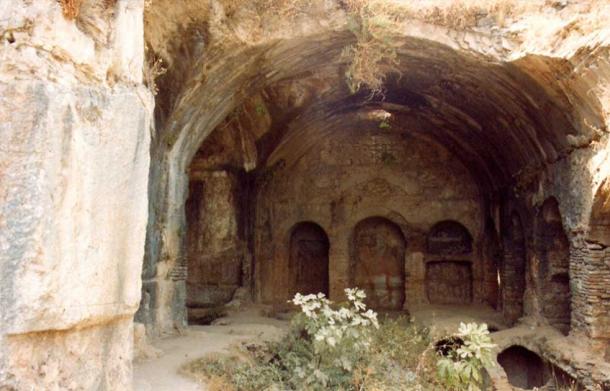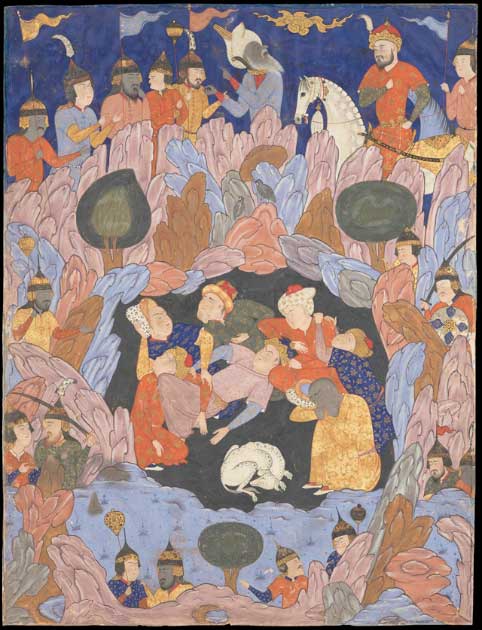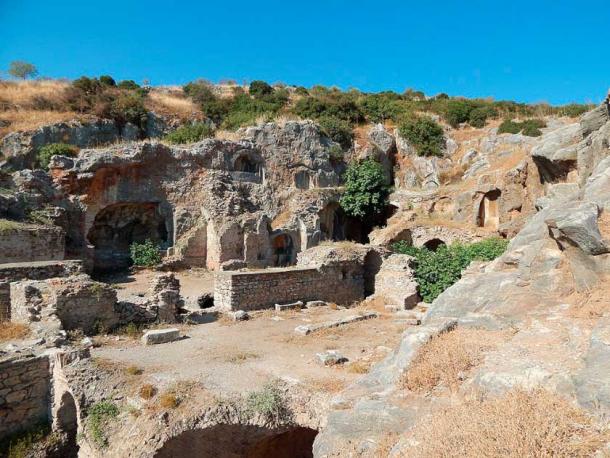
The Ancient Grotto of the Seven Sleepers
The short story Rip Van Winkle, written in 1819 by the American writer Washington Irving, is about a man who woke up after a sleep of more than two decades. Although such a work of fiction is a relatively modern piece of writing, tales of people who fall asleep for an extraordinarily long period of time before waking up is a common motif in various cultures. One such story is the Grotto of the Seven Sleepers. Unlike the story of Rip Van Winkle, however, this story has a strong religious facet.

The grotto of the seven sleepers in Ephesus, Turkey. Source: (Klaus-Peter Simon / CC BY 3.0)
Decius and the Ancient Grotto of the Seven Sleepers
The ancient Grotto of the Seven Sleepers is located in Ephesus, in modern day Turkey. According to the Christian version of the story, the Roman emperor Decius (249 to 251 AD) came to Ephesus to enforce his law against Christians. He found seven Christian youths, tried them, and gave them some time to consider their position before leaving the city.
- The Mysterious Veil of Veronica: Masterpiece or Miracle?
- Cave of Zedekiah: The Secret Grotto of Jerusalem
When news of Decius’ return reached Ephesus, the youths, refusing to give up their faith, decided to give their property to the poor and went to a cave on Mount Anchilos to pray and prepare for their deaths. When the Roman soldiers arrived, they found them asleep in the cave and were ordered to seal its entrance with large stones, trapping the youths inside.
About 180 years later, a wealthy landowner by the name of Adolios decided to open the cave to use it as a cattle stall. To his surprise, when he opened it up he found the youths asleep, but alive! When they awoke, they were hungry, and decided one of the youths named Diomedes into the city to buy some bread.

Decius orders the walling in of the Seven sleepers, in a 14th century manuscript. (Public domain)
Diomedes was astonished to see churches in the city, as he thought that he had only been asleep for a day. When Diomedes tried to pay for bread using old coins from the reign of Decius, the bishop was summoned. The bishop accompanied Diomedes to the cave and was told their story. The sleepers then died praising God and were declared saints.
There is a parallel story in the Qur’an. The Islamic version, however, is much less detailed than the Christian one. For instance, the Islamic version of the story does not mention the number of sleepers, or when the story took place. It does however state that the sleepers slept for 300 solar years, or 309 lunar years, and that a dog guarded the grotto.

"The Seven Sleepers of Ephesus", Folio from a Falnama (Book of Omens). (Public domain)
The Authenticity and Meaning of the Seven Sleepers Story
As with all stories in the Bible, regardless of their authenticity, these kinds of tales always served a purpose. In the case of the grotto of the seven sleepers, it seems that there was a group of heretics who denied the resurrection of the body during the time in which the sleepers are said to have awoken from their slumber. The seven sleepers were thus taken as proof of the resurrection of the body. Whether the seven sleepers did actually exist is another question altogether.
The occurrence of this so-called miracle meant that the cave was turned into a pilgrimage site. A church was later built on the cave, as evidenced by excavations carried out in the late 1920s. The transformation of the cave into a pilgrimage site would almost certainly have been a source of valuable income for the local church.
As for the Islamic version of the story, it should be placed within the context of the Qur’an. The story of the Seven Sleepers was told in order to answer a question posed to the Prophet Muhammad by the Jews of Medina via the people of Mecca in order to test his authenticity. The vagueness of the story is supposed to emphasize that such details are known only to God and are not important to man. Instead, it is the lessons that can be learnt from it that is of greater importance.
- San Juan de Gaztelugatxe: Take a Pilgrimage to the Basque Dragonstone
- The Famous Egyptian Martyr Saint Menas and His Shrine at Abu Mina
Archaeologist and historian John Bedell, suggests that the story could be understood as an echo of shamanistic beliefs. “What shamans in many cultures did was to fall into a sort of sleep, or trance, in which their souls left their bodies and explored other planes of existence,” Bedell writes on his blog BENSOZIA. “The lore of shamanism is full of shamans whose power was so great that they could do this for years; even more common are stories of shamans who did this on their first magical journeys, falling into comas of fabulous length before wakening to tell of marvelous things.”

The grotto of the seven sleepers in Turkey. (Sinan Şahin / CC BY 3.0)
Visiting the Grotto of the Seven Sleepers
While several sites have been named as the true cave of the seven sleepers, such as one in Amman, Jordan, it appears that the legend was born in Ephesus, located near to modern-day Selcuk in Turkey. The Grotto of the Seven Sleepers, known locally as Yedi Uyuyanlar, is home to several rock-cut tombs, as well as the ruins of a church which was carved into the rock.
Several hundred graves were found dating back to the 5th and 6th century AD and there are inscriptions dedicated to the seven sleepers. While it’s just 1.5 kilometers from Ephesus, in the side of Panayir Mountain, the grotto itself is usually closed to the public with a wire fence and a lock.
Top image: The grotto of the seven sleepers from the Menologion of Basil II. Source: Public domain
By Wu Mingren
References
Bedell, J. 24 September 2013. “The Seven Sleepers and the Shaman's Initiation” in BENSOZIA. Available at: https://benedante.blogspot.com/2013/09/the-seven-sleepers-and-shamans.html
Knight, K. 2012. “The Seven Sleepers of Ephesus” in New Advent. Available at: http://www.newadvent.org/cathen/05496a.htm
No name. 2014. ”July 27: SS. Maximian, Malchus, Martinian, Dionysius, John, Serapion, and Constantine, Martyrs” in Bartleby.com. Available at: http://www.bartleby.com/210/7/272.html
No name. No date. “Grotto of the Seven Sleepers” in Lonely Planet. Available at: https://www.lonelyplanet.com/turkey/aegean-coast/ephesus-efes/attractions/grotto-of-the-seven-sleepers/a/poi-sig/1247814/360864
















Comments
This story was a direct reply by God to Plato's cave. Plato being the reviver Nimrod's city system, and on the side gog Magog and the anti-christ and the new world order system. God gives a new word, they attempt to revive a "new" world.
Sounds pretty amazing to me, this got me wondering about other sleepy type characters....sure there's the obvious fairy tales including Sleeping Beauty and Snow White-who both were awakened by love's kiss, but I did a little googling and found this neat list of "Sleeping Heroes."
http://www.pitt.edu/~dash/sleep.html
love, light and blessings
AB
Lucid dreaming, or...?
I wonder how many ancients practiced Astral Projection as well. Seven having out of body experiences for 300 years sounds like quite the story;
No, most certainly not. It was through Astrology and other subjects that I became a firm believer. If of course you are refering to me.
Atheists have an aswer for every question, don't they?
Pages